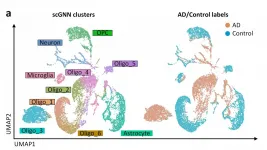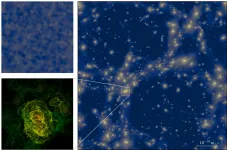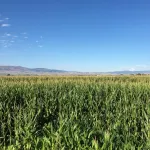(Press-News.org) ORLANDO, March 25, 2021 - Early screening can mean the difference between life and death in a cancer and disease diagnosis. That's why University of Central Florida researchers are working to develop a new screening technique that's more than 300 times as effective at detecting a biomarker for diseases like cancer than current methods.
The technique, which was detailed recently in the Journal of the American Chemical Society, uses nanoparticles with nickel-rich cores and platinum-rich shells to increase the sensitivity of an enzyme-linked immunosorbent assay (ELISA).
ELISA is a test that measures samples for biochemicals, such as antibodies and proteins, which can indicate the presence of cancer, HIV, pregnancy and more. When a biochemical is detected, the test generates a color output that can be used to quantify its concentration. The stronger the color is, the stronger the concentration. The tests must be sensitive to prevent false negatives that could delay treatment or interventions.
In the study, the researchers found that when the nanoparticles were used in place of the conventional enzyme used in an ELISA -- peroxidase -- that the test was 300 times more sensitive at detecting carcinoembryonic antigen, a biomarker sometimes used to detect colorectal cancers.
And while a biomarker for colorectal cancer was used in the study, the technique could be used to detect biomarkers for other types of cancers and diseases, says Xiaohu Xia, an assistant professor in UCF's Department of Chemistry and study co-author.
Colorectal cancer is the third leading cause of cancer-related deaths in the U.S., not counting some kinds of skin cancer, and early detection helps improve treatment outcomes, according to the U.S. Centers for Disease Control and Prevention.
The increase in sensitivity comes from nickel-platinum nanoparticle "mimics" that greatly increase the reaction efficiency of the test, which increases its color output, and thus its detection ability, Xia says.
Peroxidases found in the horseradish root have been widely used to generate color in diagnostic tests for decades. However, they have limited reaction efficiency and thus color output, which has inhibited the development of sensitive diagnostic tests, Xia says.
Nanoparticle "mimics" of peroxidase have been extensively developed over the past 10 years, but none have achieved the reaction efficiency of the nanoparticles developed by Xia and his team.
"This work sets the record for the catalytic efficiency of peroxidase mimic," Xia says. "It breaks through the limitation of catalytic efficiency of peroxidase mimics, which is a long-standing challenge in the field."
"Such a breakthrough enables highly sensitive detection of cancer biomarkers with the ultimate goal of saving lives through earlier detection of cancers," he says.
Xia says next steps for the research are to continue to refine the technology and apply it to clinical samples of human patients to study its performance.
"We hope the technology can be eventually used in clinical diagnostic laboratories in the near future," Xia says.
INFORMATION:
Study co-authors were Zheng Xi with UCF's Department of Chemistry; Kecheng Wei and Shouheng Sun with Brown University; Qingxiao Wang and Moon J. Kim with the University of Texas at Dallas; and Victor Fung with Oak Ridge National Laboratory.
Xia joined UCF's Department of Chemistry, part of UCF's College of Sciences, in 2018. He has a joint appointment in UCF's NanoScience Technology Center. Prior to his appointment at UCF, he worked at Michigan Technological University as an assistant professor and at Georgia Institute of Technology as a postdoctoral researcher. He has published more than 60 journal articles and received multiple research grants.
CONTACT: Robert H. Wells, Office of Research, robert.wells@ucf.edu
Studying genetic material on a cellular level, such as single-cell RNA-sequencing, can provide scientists with a detailed, high-resolution view of biological processes at work. This level of detail helps scientists determine the health of tissues and organs, and better understand the development of diseases such as Alzheimer's that impacts millions of people. However, a lot of data is also generated, and leads to the need for an efficient, easy-to-use way to analyze it.
Now, a team of engineers and scientists from the University of Missouri and the Ohio State University have created a new way to analyze data from single-cell RNA-sequencing ...
The very first moments of the Universe can be reconstructed mathematically even though they cannot be observed directly. Physicists from the Universities of Göttingen and Auckland (New Zealand) have greatly improved the ability of complex computer simulations to describe this early epoch. They discovered that a complex network of structures can form in the first trillionth of a second after the Big Bang. The behaviour of these objects mimics the distribution of galaxies in today's Universe. In contrast to today, however, these primordial structures are microscopically small. Typical clumps have masses of only a few grams and fit into volumes much smaller than present-day elementary particles. The results of the study have been published ...
One-third of the Earth's surface is covered by more than 11,000 grass species -- including crops like wheat, corn, rice and sugar cane that account for the bulk of the world's agricultural food production and important biofuels. But grass is so common that few people realize how diverse and important it really is.
Research published today in the journal Nature provides insights that scientists could use not only to improve crop design but also to more accurately model the effects of climate change. It also offers new clues that could help scientists use ...
Orthopaedic researchers are one step closer to preventing life-long arm and leg deformities from childhood fractures that do not heal properly.
A new study led by the University of South Australia and published in the journal Bone, sheds light on the role that a protein plays in this process.
Lead author Dr Michelle Su says that because children's bones are still growing, an injury to the growth plate can lead to a limb in a shortened position, compared to the unaffected side.
"Cartilage tissue near the ends of long bones is known as the growth plate that is responsible for bone growth in children and, unfortunately, 30 per cent of childhood and teen fractures involve this growth ...
Researchers have used the evidence of pumice from an underwater volcanic eruption to answer a long-standing mystery about a mass death of migrating seabirds.
New research into the mass death of millions of shearwater birds in 2013 suggests seabirds are eating non-food materials including floating pumice stones, because they are starving, potentially indicating broader health issues for the marine ecosystem.
The research which was led by CSIRO, Australia's national science agency, and QUT, was published in the journal Marine Ecology Progress Series, that examined a 2013 seabird "wreck" in which up to 3 million ...
A coordinated global effort to reduce the production of greenhouse gas emissions from industry and other sectors may not stop climate change, but Earth has a powerful ally that humans might partner with to achieve carbon neutrality: Mother Nature. An international team of researchers called for the use of natural climate solutions to help "cancel" produced emissions and remove existing emissions as part of a comprehensive plan to keep global warming below 1.5 degrees Celsius -- the point at which damage to human life and livelihoods could become catastrophic, according to the United Nations' Intergovernmental Panel on Climate Change.
The researchers published their invited views on March 24 in ...
Recently, the team led by Professor WU Changzheng from School of Chemistry and Materials Science from University of Science and Technology of China (USTC) in cooperation with the team led by Prof. WU Hengan from School of Engineering Science, realized the homogenization of surface active sites of heterogeneous catalyst by dissolving the electrocatalytic active metal in molten gallium. The related results have been published on the Nature Catalysis on March 11th.
Due to the existence of various defects and crystal faces, the active components on the surface of heterogeneous catalysts are often in different ...
Tsukuba, Japan - Physical exercise has long been prescribed as a way to improve the quality of sleep. But now, researchers from Japan have found that even when exercise causes objectively measured changes in sleep quality, these changes may not be subjectively perceptible.
In a study published this month in Scientific Reports, researchers from the University of Tsukuba have revealed that vigorous exercise was able to modulate various sleep parameters associated with improved sleep, without affecting subjective reports regarding sleep quality.
Exercise is ...
Lugano, Switzerland; Denver, CO, USA, 25 March 2021 - Clinical activity with a second drug inhibiting KRASG12C confirms its role as a therapeutic target in patients with advanced non-small-cell lung cancer (NSCLC) harbouring this mutation, according to results from a study with the KRASG12C inhibitor adagrasib reported at the European Lung Cancer Virtual Congress 2021. (1)
"As we strive to identify the oncogenic driver in more and more of our patients with NSCLC, it becomes critical that we develop therapies that can target these identified oncogenic drivers," said lead author Gregory Riely, from Memorial Sloan Kettering Cancer Center, New York, ...
For the first time, activation of nuclear receptor coactivator 3 (NCOA3) has been shown to promote the development of melanoma through regulation of ultraviolet radiation (UVR) sensitivity, cell cycle progression and circumvention of the DNA damage response. Results of a pre-clinical study led by Mohammed Kashani-Sabet, M.D., Medical Director of the Cancer Center at Sutter's California Pacific Medical Center (CPMC) in San Francisco, CA were published online today in Cancer Research, a journal of the American Association for Cancer Research.
"Our research suggests a previously unreported mechanism by which NCOA3 regulates the DNA damage response and acts as a potential therapeutic target in melanoma, whereby activation ...




